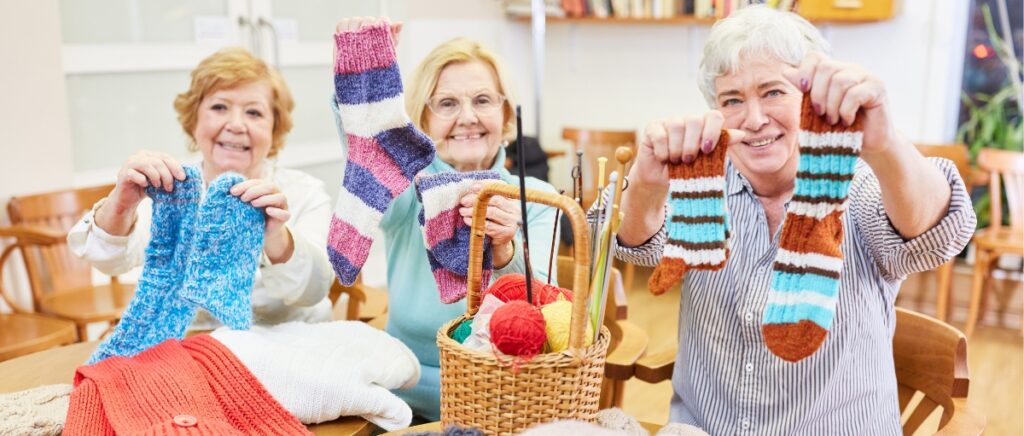Did you know that knitting is one of the fastest-growing hobbies in the United States? Over 45 million Americans know how to knit or crochet. In the past decade, the average age of knitters has been 40+, representing 81% of the knitter population.
This centuries-old craft is making a major comeback.
You’ve come to the perfect place if you’ve always wanted to learn how to knit but weren’t sure where to begin. This detailed guide will provide you with essential knitting instructions, covering everything from selecting your supplies to mastering the fundamental stitches.
You’ll feel confident and ready to take on your first knitting project by the end. So find a comfy spot, gather your materials, and immerse yourself in the delightful world of knitting!
Knitting Essentials
Before you can start knitting, you’ll need a few essential supplies. At its most basic, knitting only requires needles and yarn. But with so many options available, choosing the right ones can feel overwhelming. Let’s break it down.
Knitting Needles
Knitting needles come in various sizes, materials, and types. Here’s what you need to know:
- Sizes: Needle sizes refer to their diameter, measured in millimeters (mm). The larger the needle size, the thicker the yarn it can accommodate. Most beginners start with medium-sized needles, around 5-6 mm.
- Materials: Needles can be made from metal, plastic, bamboo, or wood. Bamboo or wood needles are often best for beginners because they have a slightly grippy surface that prevents stitches from slipping off.
- Types: Knitting needles come in three main types: straight, circular, and double-pointed. As a beginner, you’ll likely start with straight needles, which are the simplest to use.
Tip: If you need help determining which size needles to get, check the label on your yarn. It will typically recommend a needle size range that works well with that yarn weight.
Yarn
Yarn is the material you’ll use to create your knitted fabric. It comes in a dizzying array of colors, textures, and fibers. When you’re just starting, look for yarn that is:
- Medium weight: Yarns are categorized by thickness, from super fine (1) to jumbo (7). Beginners usually have an easier time with medium-weight yarns, called worsted weight (4). These yarns are thick enough to work with comfortably but not too bulky.
- Smooth texture: Some yarns have a fuzzy halo or bumpy texture that, while beautiful, can be tricky for beginners. Opt for a soft yarn that will make it easier to see your stitches.
- Light color: Dark-colored yarns can make it harder to see individual stitches, so start with a light shade. You don’t have to choose plain white—a soft pastel or heather gray will work just as well.
- Fiber content: Wool or wool-blend yarns are stretchy and forgiving, making them an excellent choice for beginners. Acrylic yarns are another good option—they’re affordable, easy to care for, and come in endless colors.
Tip: Save the hand-dyed merino and silk-blend yarns for later. For your first projects, choose a basic, inexpensive yarn. You’ll make a few mistakes as you learn and won’t feel guilty about wasting pricey yarn.
Notions and Accessories
In addition to needles and yarn, there are a few other tools that will make your knitting easier and more enjoyable:
- Scissors: You’ll need a pair of scissors to cut your yarn when you finish your project or want to change colors. Small embroidery scissors work well.
- Tapestry needle: This is a large, blunt needle used to weave in the ends of yarn when knitting is complete.
- Stitch markers: These small rings or clips can be placed between stitches to mark the beginning of a round, pattern repeats, or other important points in your knitting.
As you progress in your knitting journey, add other tools to your knitting kit, like a stitch gauge for checking your knitting’s size or a row counter to keep track of your progress. But for now, needles, yarn, scissors, and a tapestry needle are all you need to jump in.
Getting Started: Casting On Stitches
Before you can start knitting, you need to get your yarn on your needles. This process is called casting on, creating the foundation row of stitches upon which you’ll build your knitting.
There are many different methods for casting on, but one of the most versatile and beginner-friendly is the long-tail cast-on. This method creates a stretchy, neat edge that works well for most projects. Here’s how to do it:
Long-Tail Cast-On Tutorial
- Start by making a slip knot on your needle, leaving a long tail of yarn (about four times the width of your project). The slip knot counts as your first stitch.
- Hold the needle with the slip knot in your right hand and the yarn in your left hand. Spread your thumb and index finger apart, creating a triangle shape.
- Drape the yarn tail over your left thumb and the working yarn (the strand attached to the ball) over your left index finger. Hold both strands securely.
- Insert the needle under the strand on your thumb, then over the strand on your index finger.
- Use the needle tip to draw the index finger strand under the thumb strand and through the loop on your thumb.
- Drop the loop off your thumb and tighten the new stitch on the needle by pulling both strands of yarn.
- Repeat steps 4-6 until you have the desired number of stitches on your needle.
Watching a knitting tutorial can be helpful if you’re a visual learner. Here’s a great one that demonstrates the long-tail cast-on step by step.
Here are a few tips as you practice casting:
- Before you start, make sure you have enough tail yarn. You’ll need about 1 inch of tail for each stitch you plan to cast on.
- If your stitches are too tight and difficult to knit into, try casting on with two needles held together. When you’re done, simply slip one needle out and start knitting with the other.
- Don’t worry if your first few rows look uneven or messy. Casting on takes practice! Focus on maintaining an even tension, and the motions will feel more natural.
Remember, every knitter was a beginner once. Be patient with yourself as you learn this new skill. With some practice, you’ll be casting on like a pro in no time.
Basic Stitches: Knit and Purl
The knit stitch and purl stitch are the foundation of all knitting. Once you master these two stitches, you can create various textures and patterns.
The Knit Stitch
The knit stitch is the most basic stitch in knitting. Here’s how to do it:
- Hold the needle with your cast-on stitches in your left hand and the empty needle in your right hand. The working yarn should be behind the needle with the stitches.
- Insert the right needle into the first stitch on the left needle, from front to back.
- Wrap the working yarn counterclockwise around the right needle.
- Use the right needle to pull the wrapped yarn through the stitch on the left needle, creating a new loop.
- Slide the original stitch off the left needle, leaving the new stitch on the right needle.
Repeat steps 2-5 until you’ve knit all the stitches on your left needle.
Tip: Remember to keep your stitches close to the needle tips and maintain an even tension. If your stitches are too tight, they’ll be hard to knit into on the next row, and if they’re too loose, your fabric may look uneven.
The Purl Stitch
The purl stitch is the reverse of the knit stitch. Here’s how to do it:
- Hold the needle with your stitches in your left hand and the empty needle in your right hand. The working yarn should be in front of the needle with the stitches.
- Insert the right needle into the first stitch on the left needle, from back to front.
- Wrap the working yarn counterclockwise around the right needle.
- Use the right needle to pull the wrapped yarn back through the stitch on the left needle.
- Slide the original stitch off the left needle, leaving the new stitch on the right needle.
Repeat steps 2-5 until you’ve purled all the stitches on your left needle.
When you alternate knit and purl stitches, you can create different stitch patterns, such as ribbing, seed stitch, or moss stitch. These textured patterns add visual interest and stretchiness to your knitted fabric.
Finishing Your Project
Once you’ve knit your piece to the desired length, it’s time to get it off the needles. This process is called binding off.
How to Bind Off
Binding off secures your last row of stitches so they don’t unravel. Here’s how to do the basic bind-off:
- Knit the first two stitches on your left needle as usual.
- Insert the left needle into the first stitch on your right needle.
- Lift that stitch up and over the second stitch, dropping it off the needle. One stitch has been bound off.
- Knit the next stitch and repeat steps 2-3 until only one stitch remains on your right needle.
- Cut the yarn, leaving a 6-inch tail. Pull the tail through the last stitch to secure it.
After you’ve bound off, you must weave in your loose yarn ends. Thread your yarn tail onto a tapestry needle and weave it through the back of your work, following the path of the stitches. Trim the excess yarn close to the fabric.
Tip: For a neater finish, sew your yarn tail in one direction for an inch or two, then turn around and weave back in the opposite direction. This will help prevent your end from peeking out on the right side.
Fixing Mistakes
Mistakes happen to every knitter, but they’re usually easy to fix. Here are some common beginner mishaps and how to solve them:
Dropped Stitch
If a stitch slips off your needle, don’t panic. Simply pick it up with your needle and knit or purl it as usual. If the stitch unravels down a few rows, use a crochet hook to pull the loose strand up through each loop until you reach the current row.
Twisted Stitch
It may be twisted if a stitch looks like it’s leaning the wrong way or sitting on top of its neighbors. This happens when you accidentally put your needle through the back of the loop instead of the front.
To fix it on the next row, simply knit or purl into the back of the stitch to untwist it.
Uneven Edge Stitches
Beginners often end up with loose, loopy stitches on the edges of their work. To prevent this, always work each row’s first and last stitches. Give the working yarn a gentle tug after these stitches to keep them snug against the needle.
Remember, practice makes progress. Keep going even if your first projects have a few imperfections—that’s part of the learning process. Over time, you’ll train your hands and eyes to recognize and prevent common mistakes.
Care and Feeding of Your Knits
You’ve put time and love into your knitting, so ensure it lasts! Here are some tips for keeping your knits looking their best:
- Blocking: is the process of wetting or steaming your finished piece to even out the stitches and help it hold its shape. Soak your knitted item in cool water with a gentle soap for natural fibers like wool. Gently squeeze out the water (don’t wring or twist) and lay it flat to dry, patting it into the desired shape and size. Use a steamer or iron on low heat with a damp towel over your knitting for synthetic fibers or items that need a crisp finish.
- Storage: To prevent moths and other pests from snacking on your woolens, store them in airtight bags or boxes with cedar balls or lavender sachets. Avoid storing knits in plastic bags, which can trap moisture and cause mildew.
- Washing: Check your yarn label for washing instructions. Many natural fibers, like wool and cashmere, require hand washing with a gentle soap in cool water. Superwash wools and synthetic blends can often be washed in the washing machine on a delicate cycle. Always lay your knits flat to dry rather than putting them in the dryer.
Your Knitting Adventure Awaits
You now have all the tools and techniques to embark on your knitting journey! As a beginner, it’s best to start with simple, rectangular projects like scarves, dishcloths, or baby blankets. Look for patterns with basic stitches marked “easy” or “beginner.”
Remember, every knitter was once a beginner. In fact, 82% of knitters rate their experience levels as beginner or intermediate. Don’t be afraid to make mistakes—that’s how we learn! Embrace the process and enjoy watching your skills grow with each new project.
As you gain confidence, challenge yourself to learn new techniques. You could try knitting to make a hat or socks in the round. Or experiment with simple lace or cable patterns. There are endless possibilities to explore with just two sticks and some string.
So what are you waiting for? Grab your needles, pick a project, and start stitching! With patience and a lot of practice, you’ll be a confident, capable knitter in no time. Welcome to the beautiful, woolly world of knitting!
Sources
We Are Knitters. (2023). Knitting statistics: Surprising insights into the world of yarn and needles. Knit Like Granny. https://knitlikegranny.com/knitting-statistics/
Zippia. (2023). Knitter demographics and statistics in the US. Zippia. https://www.zippia.com/knitter-jobs/demographics/
Knit Like Granny. (2023). Knitting statistics: Fascinating facts about the craft. Knit Like Granny. https://knitlikegranny.com/knitting-statistics/











